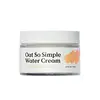What's inside
What's inside
 Key Ingredients
Key Ingredients

No key ingredients
 Benefits
Benefits

 Concerns
Concerns

No concerns
 Ingredients Side-by-side
Ingredients Side-by-side

Water
Skin ConditioningPropanediol
SolventSqualane
EmollientGlycerin
HumectantCetearyl Alcohol
EmollientEthylhexyl Olivate
Skin ConditioningPolyglyceryl-6 Distearate
EmulsifyingRaphanus Sativus Seed Extract
Skin ConditioningIsopentyldiol
HumectantButylene Glycol
HumectantArnica Montana Extract
Skin ConditioningCamellia Sinensis Extract
AntioxidantArgania Spinosa Sprout Cell Extract
Skin ConditioningSalix Nigra Bark Extract
Skin ProtectingCannabis Sativa Seed Oil
EmollientPunica Granatum Seed Oil
EmollientTrifolium Pratense Flower Extract
AstringentAlteromonas Ferment Extract
Skin ConditioningAloe Barbadensis Leaf Extract
EmollientSodium Hyaluronate
HumectantCurcuma Longa Root Extract
MaskingJojoba Esters
EmollientLactobacillus Ferment
Skin ConditioningHibiscus Esculentus Fruit Extract
Skin ConditioningCetyl Alcohol
EmollientDiglucosyl Gallic Acid
Xanthan Gum
EmulsifyingThioctic Acid
AntioxidantErythritol
HumectantPolylysine
Vaccinium Angustifolium Fruit Extract
Skin ProtectingMentha Piperita Extract
CleansingCaprylhydroxamic Acid
1,2-Hexanediol
Skin ConditioningWater, Propanediol, Squalane, Glycerin, Cetearyl Alcohol, Ethylhexyl Olivate, Polyglyceryl-6 Distearate, Raphanus Sativus Seed Extract, Isopentyldiol, Butylene Glycol, Arnica Montana Extract, Camellia Sinensis Extract, Argania Spinosa Sprout Cell Extract, Salix Nigra Bark Extract, Cannabis Sativa Seed Oil, Punica Granatum Seed Oil, Trifolium Pratense Flower Extract, Alteromonas Ferment Extract, Aloe Barbadensis Leaf Extract, Sodium Hyaluronate, Curcuma Longa Root Extract, Jojoba Esters, Lactobacillus Ferment, Hibiscus Esculentus Fruit Extract, Cetyl Alcohol, Diglucosyl Gallic Acid, Xanthan Gum, Thioctic Acid, Erythritol, Polylysine, Vaccinium Angustifolium Fruit Extract, Mentha Piperita Extract, Caprylhydroxamic Acid, 1,2-Hexanediol
 Reviews
Reviews

Ingredients Explained
These ingredients are found in both products.
Ingredients higher up in an ingredient list are typically present in a larger amount.
1,2-Hexanediol is a synthetic liquid and another multi-functional powerhouse.
It is a:
- Humectant, drawing moisture into the skin
- Emollient, helping to soften skin
- Solvent, dispersing and stabilizing formulas
- Preservative booster, enhancing the antimicrobial activity of other preservatives
Butylene Glycol (or BG) is used within cosmetic products for a few different reasons:
Overall, Butylene Glycol is a safe and well-rounded ingredient that works well with other ingredients.
Though this ingredient works well with most skin types, some people with sensitive skin may experience a reaction such as allergic rashes, closed comedones, or itchiness.
Learn more about Butylene GlycolSqualane is an emollient that helps the skin hold onto moisture. It's an oily liquid that occurs naturally in certain types of fish and plant oils.
Because squalane boosts hydration in the skin, it also comes with plenty of benefits: it is an antioxidant and can help fight free radicals and skin damage. Squalane is also found to have a detoxifying effect when applied.
Squalane comes from squalene, which occurs naturally within the sebum of our skin. It is one of the oils our skin produces to keep itself hydrated. Squalane is the hydrogenated version of squalene and has a longer shelf life.
Research shows that squalane is non-irritating (even at 100% concentration).
In general, it's a fantastic ingredient. It does a great job at hydrating the skin, and it's suitable for those with sensitive skin.
The source of squalane may impact malassezia / fungal acne. This is because olive oil derived squalane can contain impurities such as fatty acids and plant waxes. Sugarcane derived squalane is recommended for anyone with malassezia concerns.
Is squalane vegan?
This depends on the source. Squalane can be derived from both plants and animals. Most squalane used in skincare comes from plants.
Please note: the source of squalane is only known if disclosed by the brand. We recommend reaching out to the brand if you have any questions about their squalane.
Read more about squalene with an "e".
Is squalane an oil?
Squalane is often called an oil, but it’s technically not; it’s a hydrocarbon, meaning it’s only made of carbon and hydrogen, unlike true oils which are triglycerides made of fatty acids and glycerol.
The term “oil-free” isn’t regulated, so companies can define it however they want. Some exclude all oils, while others just avoid mineral oil or comedogenic oils.
While some people avoid oils thinking they cause breakouts, the right kind of oil (or oil-like ingredient like squalane) can actually help balance and hydrate your skin. It’s worth testing out simple oils or squalane to see what works best for your skin.
Learn more about SqualaneWater. It's the most common cosmetic ingredient of all. You'll usually see it at the top of ingredient lists, meaning that it makes up the largest part of the product.
So why is it so popular? Water most often acts as a solvent - this means that it helps dissolve other ingredients into the formulation.
You'll also recognize water as that liquid we all need to stay alive. If you see this, drink a glass of water. Stay hydrated!
Learn more about Water